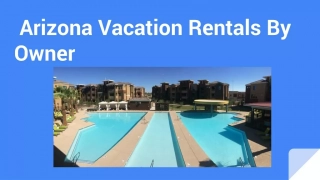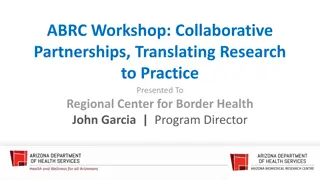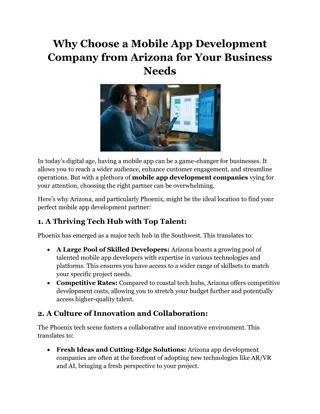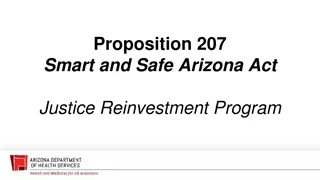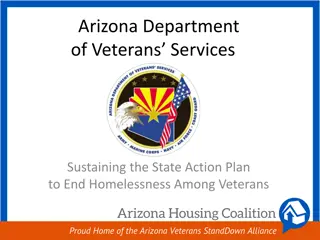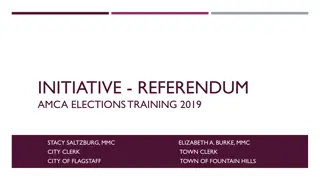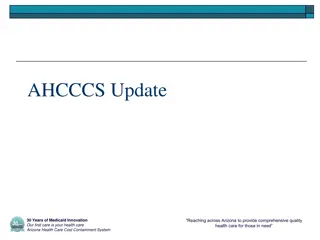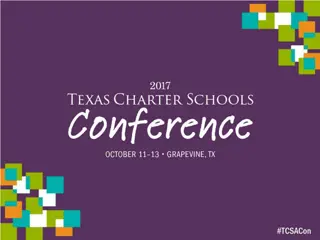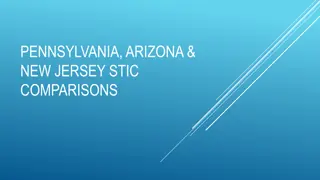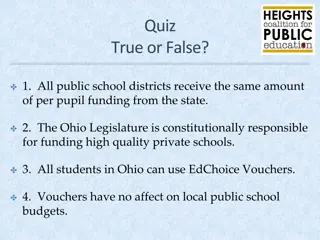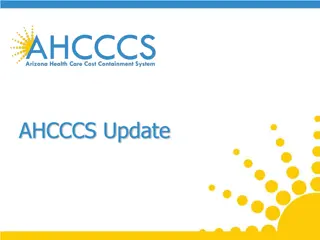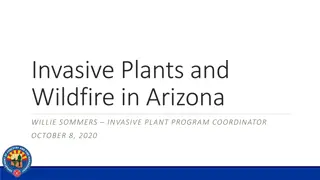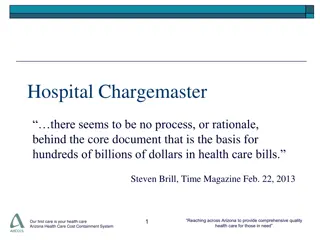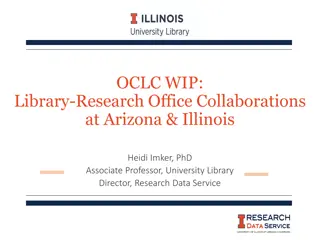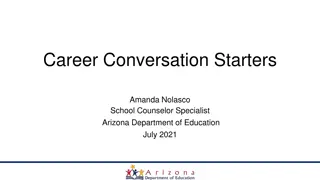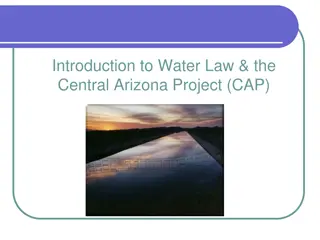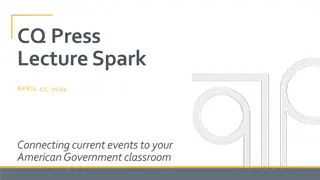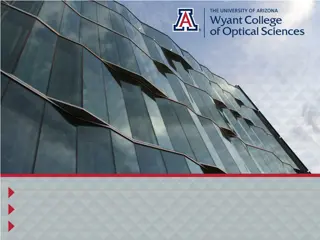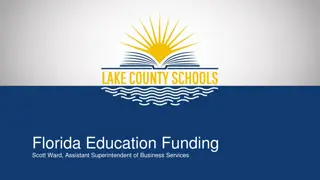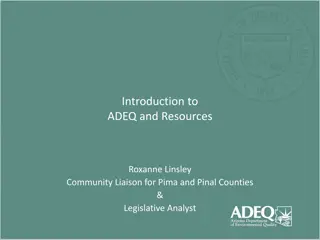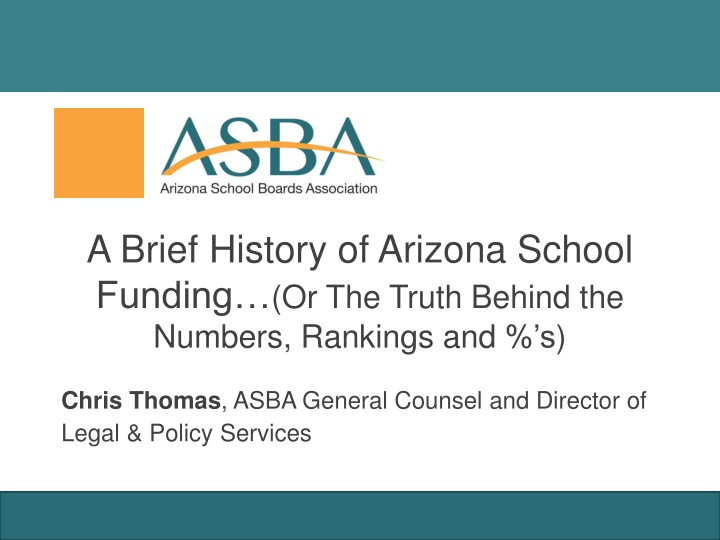
Revealing Arizona's Education Funding Crisis
Explore the truth behind Arizona's school funding numbers, rankings, and percentages, as presented by Chris Thomas, ASBA General Counsel. Dive into questions about funding categories, historical trends, the importance of rankings, differing perspectives, and actionable solutions to address the issue.
Uploaded on | 0 Views
Download Presentation

Please find below an Image/Link to download the presentation.
The content on the website is provided AS IS for your information and personal use only. It may not be sold, licensed, or shared on other websites without obtaining consent from the author. If you encounter any issues during the download, it is possible that the publisher has removed the file from their server.
You are allowed to download the files provided on this website for personal or commercial use, subject to the condition that they are used lawfully. All files are the property of their respective owners.
The content on the website is provided AS IS for your information and personal use only. It may not be sold, licensed, or shared on other websites without obtaining consent from the author.
E N D
Presentation Transcript
A Brief History of Arizona School Funding (Or The Truth Behind the Numbers, Rankings and % s) Chris Thomas, ASBA General Counsel and Director of Legal & Policy Services
5 questions we seek to answer today 1. Where does Arizona rank in the various school funding categories? 2. Has it always been this way? 3. What do those rankings mean/do they matter? 4. Why do we hear different numbers from other groups that give a different perspective and how do they come up with them? 5. What Can We Do About It?
1. Where does Arizona rank in the various school funding categories?
Per Pupil Amounts for Current Year Spending (U.S. Census, State/Local, FY2013) Arizona: $7,208 National Avg: $10,700 Arizona State Rank: 49 (Out of 51)
Per Pupil Amounts for M&O Purposes From All Sources (U.S. Census, FY2013) Arizona: $8,599 National Avg.: $12,380 Arizona State Rank: 49
Arizona State K-12 Funding By Resource (% of money from a Particular Source Federal, Local and State (U.S. Census, FY2013) Federal Funding: 14.6% (5th) Local Funding: 49.2% (18th) State Funding: 36.2% (48th) Growth in Resources from Federal, Local and State Sources 1992-2013 (Actual not Constant - Dollars) Federal Funding Sources: Up 176.15% Local Funding Sources: Up 76.99% State Funding Sources: Up 49.3%
Ranked by State Sources Alone, Arizona has fallen to 50thin per pupil funding $3,018 per pupil 53.8% of national avg.
Education Week Quality Counts 2015: Spending
Adjusted Per-Pupil Expenditures (PPE) Analysis counts for regional cost differences Includes all revenue sources Arizona state average: $8,101 National average: $11,735 Arizona Rank: 50 (of 51)
Students Funded at or Above the National Average Percent of students in districts with PPE at or above U.S. average Arizona state average: 0.7% National average: 43.4% Arizona Rank: 51 (of 51)
State Expenditures on K-12 Schooling as a Percent of State Taxable Resources Arizona state average: 2.5% National average: 3.4% Arizona rank: 47 (of 51)
Funding Equity The Good News! (Or, The Good News?)
Wealth-Neutrality Score Relationship between district funding and local property wealth The degree to which state and local revenue are related to property wealth of districts State Avg: 0.110 National Avg.: 0.139 Arizona State Ranking: 19
McLoone Index Actual spending as percent of amount needed to bring all students to median level of state State Avg.: 94.8% National Avg.: 90.8% Arizona State Ranking: 4
Coefficient of Variation Amount of Disparity in spending across a state among districts State Avg.: 0.144 National Avg.: 0.167 Arizona State Ranking: 15
Restricting Range Difference in per-pupil spending levels at the 95thand 5thpercentiles State Avg.: $2,614 National Avg.: $4,559 Arizona State Ranking: 7
The Good News? There is evidence that in a low tax state such as Arizona - equity comes at the expense of local control and depresses overall funding
What About Capital Funding? Most Capital Funding Now at Local Level Building Renewal Formula Repealed in 2014 Full Funding of Formula in FY2014 Was $260 Million; Actual Funding was $14 Million for Grant-Based Program No New School Construction Funding Provided By State Lawsuit About to Be Filed
So where does Arizona rank in the various school funding categories?
In 2015, Arizona ranks at or near the bottom on state funding of M&O K-12 education In 2015, Arizona has a funding system that is among the top states in equity of resources BUT this is based on all districts having low overall funding Lack of state funding of capital is resulting in both low funding and inequity since most capital funding is paid from voter approved bonds which are based on local property wealth and local voter support
Change in Ranking 1991-92: AZ Ranked 34th above 16 other states (87.7% of U.S. Average) 2012-13: AZ Ranked 48thabove 2 other states (69.5% of U.S. Average) To move back to 87.7% of U.S. Average Increase expenditures to $10,857 Increase of $2,258 per pupil
In 1991-92 AZ Above These States Alabama Arkansas Georgia Idaho# Kentucky Louisiana Mississippi Missouri New Mexico North Carolina North Dakota Oklahoma South Carolina South Dakota Tennessee Utah# #State AZ above in 2012-13
Change In Per Pupil Public School Revenue K-12 Education FY 1992- FY 2013 FY 1992 Federal Sources State Sources Local Sources Total US $361 $2,661 $2,598 $5,621 Arizona $453 $2,086 $2,391 $4,931 AZ Rank 6 39 26 34 AZ % of US Average FY 2013 125.5% 78.4% 92.0% 87.7% Federal Sources State Sources Local Sources Total US $1,126 $5,650 $5,603 $12,380 Arizona $1,251 $3,116 $4,232 $8,599 AZ Rank 17 50 31 48 AZ % of US Average 111.1% 55.1% 75.5% 69.5%
AZ K12 State Funding Rank Per Pupil vs. U.S. Average FY 1993 FY 2013 RANK $ AZ 41 2102 43 2084 41 2264 42 2419 43 2387 44 2458 46 2664 46 2910 44 3110 45 3285 YEAR $ U.S. Average 2698 2765 2961 3104 3288 3473 3715 3974 4253 4396 % AZ/U.S. 77.9% 75.4% 76.5% 77.9% 72.6% 70.8% 71.7% 73.2% 73.1% 74.7% 1992-93 1993-94 1994-95 1995-96 1996-97 1997-98 1998-99 1999-00 2000-01 2001-02
AZ K12 State Funding Rank Per Pupil vs. U.S. Average continued FY 1993 FY 2013 YEAR RANK 2002-03 45 3283 2003-04 44 3411 2004-05 44 3469 2005-06 44 3619 2006-07 41 4335 2007-08 40 4516 2008-09 47 3877 2009-10 48 3257 2010-11 49 3227 2011-12 50 3018 2012-13 50 3116 $ AZ $ U.S. Average 4525 4553 4774 5018 5466 5805 5725 5352 5509 5609 5650 % AZ/U.S. 72.5% 74.9% 72.7% 72.1% 79.3% 77.8% 67.7% 60.9% 58.5% 53.8% 55.1%
Providing for Inflation Funding 1982-1992 Inflation provided Inflation Funding 1992-2000 less than a third of what inflation was Great growth in state revenues during this time other states invested those revenues in education while Arizona did not
School Reform Relationship to School Funding Decline
1995: Arizona passes most expansive charter school law in country as well as open enrollment and site-based decision making 1997: Student Tuition Tax Credit for private schools 2006: School vouchers (ruled unconstitutional in 2009) 2011: Empowerment Scholarship Accounts
The Philosophy of the reformers With additional school choice, there is school competition competition will drive greater student achievement with more money don t put money into a broken system private enterprise is more efficient than government and can do more with less
Effect of Great Recession on Arizona s K-12 Funding (Since FY2009) Capital Outlay Revenue Limit (CORL, repealed starting FY2014): -$144M Soft Capital (Repealed starting FY2014): -$676.4M District Additional Assistance (started in FY2014): -$239M Elimination of Full Day Kindergarten: -$218.3M Career Ladder Phase-Out (not all districts received): - $70M (only -$29M to state) Excess Utilities: -$183M Building Renewal: -$1.6B
According to U.S. Census, Arizona cut K-12 education more than any other state in the country And Arizona was ranked 47th in funding BEFORE the Great Recession Overall cuts during Great Recession: $3.4B
Has It Always Been This Way? No, it hasn t always been this way. Arizona used to be in the middle of the pack as far as education funding but has fallen to the bottom because of a diminishing amount of state support since the early- to mid- 90 s and cuts during the great recession
3. What do those rankings mean/do they matter? Survey after survey shows that people care about educational quality and public accountability and see funding in that context. They will not support more funding for the sake of more funding they want bang for the buck
Does more funding equal better student achievement? Never going to be a one-to-one ratio and there will be outliers (DC) But more evidence than not, shows YES there is a correlation Of top 10 states student achievement as measured in latest Education Week Quality Counts Report, only three were in bottom half of states in funding Avg. Funding ranking of top 10 achieving states was 18
Education week quality counts top 10 states in student achievement (with funding ranking) 1. MA 83.7 (10) 2. MD 83.1 (6) 3. NJ 82.1 (5) 4. NH 78.8 (16) 5. VT 77.3 (8) 6. MN 76.7 (20) 7. FL 75.8 (37) 8. PA 75.6 (11) 9. WA 74.9 (29) 10. CO 74.2 (40) 38. AZ 66.6 (48)
Strong evidence that highly qualified teachers result in higher student achievement Strong evidence that salaries drive availability and quality of personnel 85-90% of school district budgets are in employee salaries and benefits Arizona Teacher Shortage: Record Number of Vacancies for 2015-16 School Year AZ Avg. Salary: $47,000 (U.S. $54,000; AZ ranks 40); gap is widening AZ Avg. Starting Salary: $32,000 Shortage of school superintendents, principals and assistant principals as well
Low funding means higher class sizes AZ currently has 10th highest class sizes in U.S. (NEA)
3. What do those rankings mean/do they matter? They mean that student achievement is negatively affected by low levels of funding, resulting in reduction of programs and qualified teachers and other school personnel to educate them.
4. Why do we hear different numbers from other groups that give a different perspective and how do they come up with them? Often it s a comparing-apples-to-oranges problem or different perspective
Often proportional capital or local funding is added to state per pupil funding and then that number is compared to national figures don t include this same added funding
Overall funding for K-12 is considered without breaking it out on a per pupil basis Because Arizona is a growing state, the amount of money going into the system is increasing but not in proportion to per pupil spending Legislators often see K-12 spending as a single line-item in the budget and see it going up when on a per pupil basis it may be going down or relatively flat
Example: Arizona Tax Research Association (ATRA) Report On K-12 General Fund Spending Increases Since 1992 Show Arizona Has Grown K-12 Spending the 9th Most in the U.S. Why? Student Growth AZ #2 in Student Growth Since 1992 Arizona in Top 10 States in Percentage of Population Under the Age of 18 #13 in Percentage of Population Over 64 #49 in Percentage of Population 18-64
Other common approaches Sometimes per capita funding is used to present a different perspective Cost of living is sometimes considered
4. Why do we hear different numbers from other groups that give a different perspective and how do they come up with them? Student growth, inclusion of capital and per capita methodologies while not always doing the same thing for other states presents policymakers a skewed perspective on Arizona school funding and complicates getting out a clear factual message about the rankings and what they mean.
5. What Do We Do About It? Advocate, Litigate and Legislate!
ADVOCATE! Do it smart Danger of using rankings: $4 Billion to move AZ to National Average Don t want policymakers to say why bother?
Advocate! (1) Keep in mind Prop. 108 (2) Stay in conversations about more funding (3) Have to play with the players you have Know History Beware of polls Prop. 301 (2000), Prop. 100 (2010): Simple Plan + Strong Public Support + Business Community Support/Neutral + Governor Support = Ballot Win Any of the above aren t there, the outcome has not been good (ACE Initiative in 1990, Prop. 204 in 2012)*
Prop. 123 The Good News: Prop. 123 passed in 12 of 15 counties Especially significant was running up the score in Pinal, Yuma, Mohave and Apache The Bad News: Prop. 123 failed badly in three counties: Coconino 42.5% yes, 57.5% no Pima 46.3% yes, 53.7% no Yavapai: 47% yes, 53% no
Why Was It So Close? Race was always close internal polls showed support always hovered around 50% Distrust of government by both sides of the political aisle Toxic political environment Governor a polarizing figure, especially for voters traditionally inclined to support more education funding; people don t believe government will do what it says it will do

